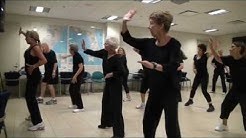ORHPC Publications
Related Sites
Contact Info
ORHPC Spotlight on healthy aging in rural areas, March 2019
Improving access and participation in fitness and wellness opportunities for older adults across rural Minnesota
Introduction
In 2017, frustrated by the lack of consistent and appropriate exercise opportunities for older adults in Hibbing, a group of “ladies in town” asked the Minnesota Department of Health's Rural Health Advisory Committee (RHAC) to study the barriers facing older rural adults who want to be physically active. Staying healthy improves the ability of older adults to age in their own homes, have less reliance on home care and nursing facilities, and ultimately have higher quality of life with less public cost. An important component to staying healthy is ensuring that adults living in rural Minnesota have continued access to local opportunities for physical activity.
This Spotlight highlights both RHAC's report on older adult fitness in rural Minnesota, and the successful efforts of Hibbing's community members to align regional resources and funding and create a successful, on-going, structured physical activity program. Their newly established community fitness program meets the minimum physical activity guidelines for older adults, is available locally, and has instructors and a curriculum that encourages regular attendance and social interaction. RHAC’s publication, Older adult fitness: Access and participation in rural Minnesota, 2018 (PDF), includes a community fitness implementation model that can be used by leaders and fitness professionals in other rural communities.
Minnesota Department of Health's Community Fitness in Rural Minnesota Video
When older adults are physically active they not only experience improved health outcomes and a better quality of life, but they also experience increased social and community engagement. Staying healthy improves the ability of older adults to be active in their communities as home owners, tax payers, consumers of goods and services, participants in the workforce, volunteers, and as contributors in many other ways. It also generally means a higher quality of life.
Physical activity guidelines for Americans
Recent updates to the Physical Activity Guideline for Americans, 2nd edition 9 (PDF) place increased importance on benefits of physical activity for older adults. They recommend “multi–component physical activities” that combines aerobic activity, muscle strengthening, flexibility and balance exercises every week. The guidelines also recommend that older adults with chronic disease or other health concerns be as physically active as they are able. Everyone should base their physical activity efforts on their own level of fitness.
Data
The statistics are familiar to us—44 percent of rural populations are over the age of 50; 30 percent are over 65 years of age and people in rural communities are twice as likely to be age 80 or older (MN Demographic Center, 2016). The forecast is for the rural older adult population to increase by 10% in the next decade. What is especially alarming is that 25 percent of adults over age 50 do not engage in regular physical activity and are becoming significantly more inactive with age (Centers for Disease Control and Prevention, 2016). Meanwhile, consistent access to appropriate physical activity opportunities is a challenge facing rural communities across Minnesota. (Older Adult Fitness: Access and Participation in Rural MN, Health Advisory Committee, 2018 (PDF).
Rural Health Advisory Committee report
RHAC’s Senior Wellness Workgroup recognized that rural leaders and community perceptions of aging play a significant role in implementing new ideas in rural communities. They emphasized that older adult participation, contributions and inclusion in activities are all important components in promoting successful aging–in–place strategies. The workgroup identified common barriers to providing appropriate, scalable, and affordable physical activity opportunities for older adults. In addition, they developed recommendations to address these barriers. Their recommendations included:
- Using a community fitness implementation model to respond to need
- Developing dedicated funding for rural older adult physical activity programs and initiatives
- Retaining and reimbursing a qualified workforce for physical activity classes
- Educating and facilitating connections between health care providers and community physical activity and fitness efforts for rural residents
- Improving transportation options to and from fitness programs and community locations
The workgroup noted that in rural areas, community members are often the ones that make things happen. RHAC’s older adult fitness report includes a model for implementing community fitness to help community leaders and fitness professionals inspire and lead local residents in creating physical activity opportunities. Policy changes and public investments are often required to achieve the goal of healthy older adults living in vibrant rural communities. In Hibbing’s example, a “group of ladies in town” with a common goal was the “secret sauce” that inspired a larger community effort to solve their problem and create a sustainable solution. In all communities, local initiative and creativity can lead to successful rural aging–in–place strategies.
Conclusion
RHAC would like to thank the Senior Wellness Workgroup members for their insights and contributions in developing a community fitness model and policy recommendations, as well as an in-depth list of examples and resources for stakeholders to use for strengthening physical activity opportunities in rural Minnesota. Lastly, a hearty “thank you” goes out to the Hibbing area older adults who were the impetus for forming a statewide workgroup and for showing us all how grass roots innovation and determination can make things happen!

Additional Resources
- Physical Activity Basics and Your Health | Physical Activity Basics | CDC
- Physical Activity: Social Support Interventions in Community Settings - Healthy People 2030 | health.gov
- Physical Activity Basics - MN Dept. of Health (state.mn.us)
Our contact information
651–201–3838
health.orhpc@state.mn.us